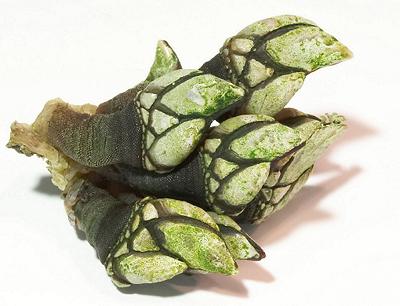 [Gooseneck Barnacle, Percebes (Spain, Portugal), Pollicipes polymerus
and similar species]
[Gooseneck Barnacle, Percebes (Spain, Portugal), Pollicipes polymerus
and similar species]
This is the Goose Barnacle of commerce and the plate. They attach to rocks in the intertidal zone with their feathery feet facing away from the waves. They catch food going by in the outflow.
Because they prefer rugged rocky environments with big waves they are dangerous to gather. They are gathered along the Iberian Peninsula (most are eaten in Spain and Portugal) and along the Pacific Northwest of the U.S. and Canada. Gathering them is tightly controled in the Pacific Northwest and licenses are required for posession. Photo © i0122.
Barnacle gathering on the West Coast of Canada has been reopened after a 4 year halt to establish environmental controls. A commercial license is required for gathering and or posession in the U.S. and exact methods for gathering are tightly controlled in both countries.
Gathering Goose Barnacles is difficult and dangerous. Every year people die gathering them along the Iberian peninsula in Europe and the Pacific Northwest coast of North America. Experimental commercial aquaculture is being established in the Pacific Northwest to meet increasing demand.
More on Barnacles.
Goose Barnacles are eaten mainly in Spain and Portugal but also end up on the plate in other European countries and are increasingly eaten in North America. Only the fleshy stems of Goose Barnacle are edible.
Goose Barnacles are often described as tasting much like crab claw. They are simply scrubbed clean with a brush and are then steamed whole (and live), often over a broth of wine and herbs. The skin is peeled from the stem (peduncle) and the stems are eaten with a dip or in soups or chowders. The calcarous "capitulum" containing the body is discarded - nothing there to eat.